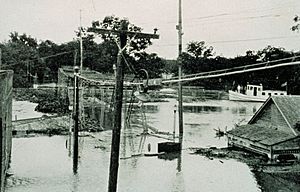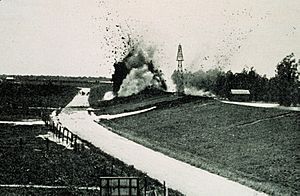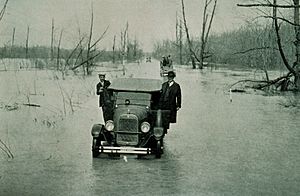Great Mississippi Flood of 1927 facts for kids
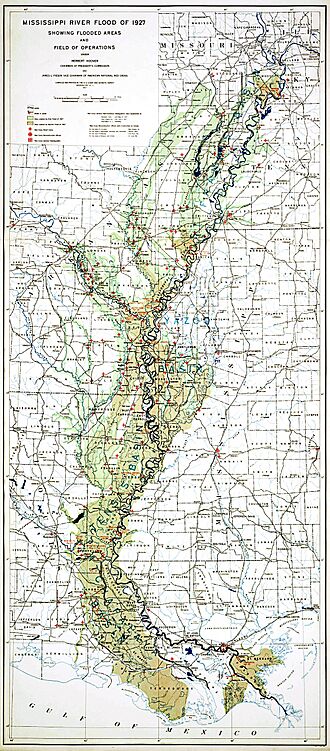
Mississippi River Flood of 1927 showing flooded areas and relief operation
|
|
| Date | 1926–1929 |
|---|---|
| Location | Particularly Arkansas, Louisiana, and Mississippi along with Missouri, Illinois, Kansas, Tennessee, Kentucky, Oklahoma, and Texas |
| Deaths | about 500 |
The Great Mississippi Flood of 1927 was the worst river flood in the history of the United States. It covered about 27,000 square miles (70,000 km²) of land. Some areas were under 30 feet (9 meters) of water for several months in early 1927. The damage cost between $246 million and $1 billion at the time.
About 500 people died, and over 630,000 people were directly affected. Most of these people (94%) lived in Arkansas, Mississippi, and Louisiana. The Mississippi Delta region was hit especially hard. More than 200,000 African Americans lost their homes along the Lower Mississippi River. They had to live in special relief camps for a long time. Because of this, many moved north in what was called the Great Migration. They preferred to find new lives in cities rather than return to farm work.
To stop future floods, the government built the world's longest system of levees and floodways. Herbert Hoover, who was Secretary of Commerce then, managed the crisis well. This helped him become president in 1928. The disaster also led to Huey Long being elected governor in Louisiana.
Contents
Understanding the Great Flood of 1927
The United States knew about the risk of floods along the Mississippi River. This huge river drains 40% of the country's land. In 1879, the government created the Mississippi River Commission. Its job was to make the river deeper, improve shipping, and prevent big floods.
The commission decided to build many levees along the river. Levees are like walls that hold the river in its channel. Some experts, like James Buchanan Eads, warned that this might make floods worse. They thought squeezing a swollen river between walls would make it more powerful.
How the Flood Started
The flooding began in the summer of 1926 because of very heavy rain. This rain fell across the central part of the river's basin. By September, rivers that flow into the Mississippi in Kansas and Iowa were already full. On Christmas Day 1926, the Cumberland River in Nashville, Tennessee, reached its second-highest level ever.
The flood got worst in the Lower Mississippi River. This was near Mound Landing, Mississippi, and Arkansas City, Arkansas. The levees broke in at least 145 places along the river.
Impact of the Floodwaters
The water covered more than 27,000 square miles (70,000 km²) of land. Over 700,000 people lost their homes. About 500 people died because of the flood. The damage cost around $1 billion, which was a huge amount of money back then. It was about one-third of the entire United States federal budget in 1927.
The flood affected many states. These included Missouri, Illinois, Kansas, Tennessee, Kentucky, Arkansas, Louisiana, Mississippi, Oklahoma, and Texas. Arkansas was hit the hardest. About 14% of its land was covered by floodwaters. By May 1927, the Mississippi River below Memphis, Tennessee, was 80 miles (129 km) wide.
Normally, trees, grasses, and wetlands help soak up floodwater. But much of the land around the river had been cleared. This meant the soil could not absorb the intense snow and rain.
Helping Those Affected
On April 15, 1927, New Orleans had 15 inches (380 mm) of rain in 18 hours. Parts of the city were covered in over 4 feet (1.2 meters) of water. Important bankers in New Orleans worried about the city's safety. They knew about the massive flooding happening upriver.
On April 29, they decided to blow up a levee at Caernarvon, Louisiana. They used about 30 tons of dynamite. This released a huge amount of water. Their goal was to save New Orleans from serious damage. However, this flooded the less populated St. Bernard Parish and all of Plaquemines Parish's east bank.
It turned out that blowing up the levee was not needed. Several major levee breaks happened upstream of New Orleans. These breaks released a lot of floodwater, which reduced the water reaching the city. The New Orleans businessmen did not pay for the losses of the people in the flooded parishes downriver.
To help with the disaster, Congress passed the Mississippi Flood Control Act. This law focused on building more structures in the Mississippi Delta Levee Camps. However, the NAACP (National Association for the Advancement of Colored People) warned about the harsh living conditions and poor treatment of African American workers in these camps.
After the Flood: Recovery and Changes
By August 1927, the floodwaters went down. Hundreds of thousands of people had lost their homes. Their properties, farm animals, and crops were destroyed. The flood caused "staggering" losses in terms of people affected and property damage. However, many lives were saved thanks to relief efforts. The American Red Cross played a big part in this, with help from local workers.
African Americans were hit the hardest by the flood. They made up 75% of the population in the Delta lowlands. They also did 95% of the farm work. Historians believe that 94% of the 637,000 people forced to move lived in Arkansas, Mississippi, and Louisiana. Also, 69% of the 325,146 people in relief camps were African American. In one place, over 13,000 people near Greenville, Mississippi, were gathered on a levee. They were stuck there for days without food or clean water.
Government and Social Changes
After the Great Flood of 1927, states needed money to rebuild roads and bridges. Louisiana received over $1 million from the federal government. But it also had to add a state gasoline tax to create a $30 million fund for new paved highways.
The Corps of Engineers was put in charge of controlling the Mississippi River. Under the Flood Control Act of 1928, they built the world's longest system of levees. They also built floodways, which are channels that divert too much water from the Mississippi River.
While levees helped prevent some flooding, scientists found they changed the river's flow. This accidentally caused more flooding in later years. The river's water moved faster. This stopped new soil from being deposited along the way. The levees did not stop all future floods, like a big one in 1937.
To better plan for floods, a large physical model of the river basin was built. This model helped study how the river would react to different rainfall. It was completed in 1942.
The flood caused many African Americans to join the Great Migration. This was a movement from the affected areas to cities in the North and Midwest. This movement had already started during World War I. Even after the floodwaters went down in June 1927, tensions remained.
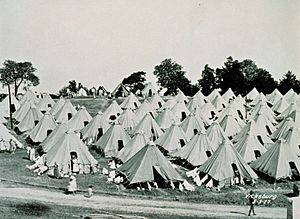
Herbert Hoover became very well-known for leading the flood relief efforts. He was the Secretary of Commerce under President Calvin Coolidge. The next year, Hoover easily won the Republican nomination for President and the election. In Louisiana, anger at the New Orleans leaders for flooding downriver areas helped Huey Long become governor in 1928.
Hoover was praised for how he managed the refugee camps, called "tent cities." These crowded camps needed basic things like water and clean toilets. Hoover tried to make the camps self-sufficient. But rural leaders were not ready to manage such large, chaotic camps. So, Hoover eventually put the relief camps under government control.
The refugee camps also had serious racial inequality. Supplies and ways to leave after the flood were mostly given to white citizens. African Americans often received only what was left over. They also had to give the name of their white employer or a voucher from a white person to get supplies. To make sure they kept working, African Americans were often forced to stay in the camps and work against their will.
Later reports about the poor treatment in the camps came out. This led Hoover to promise changes for the African American community. But he did not keep these promises. As a result, he lost the African American vote in the North when he ran for re-election in 1932. Several reports about the bad conditions in the camps were kept secret at Hoover's request. He promised more reforms for African Americans after the 1928 election. But he failed to deliver. Because of this, many influential African Americans started to support the national Democrats instead.
The Flood in Books and Songs
The Great Flood of 1927 has been featured in many forms of media:
- A documentary film called The Great Flood (2014) used old news footage of the event.
- The flood is called the "High Water of 1927" in the movie The Autobiography of Miss Jane Pittman.
- William Faulkner's story “Old Man” (from his book “If I Forget Thee, Jerusalem”) is set during the flood.
- William Alexander Percy's book Lanterns on the Levee: Recollections of a Planter's Son (1941) describes the flood in detail. It also talks about life in the Mississippi Delta.
- Many musicians have sung about the 1927 flood:
- "Mississippi Heavy Water Blues" by Barbecue Bob (1927)
- "Backwater Blues" by Bessie Smith (1927)
- "When the Levee Breaks" by Memphis Minnie and Kansas Joe McCoy (1929), later covered by Led Zeppelin
- "High Water Everywhere" by Charley Patton (1929), mentioned in "High Water (For Charley Patton)" by Bob Dylan
- "Tupelo Blues" by John Lee Hooker (1959)
- "Tupelo" by Nick Cave (1985)
- "Down in the Flood" by Bob Dylan (1967)
- "Louisiana 1927" by Randy Newman (1974)
- "Mississippi" by Bob Dylan (2001)
- "The Delta Flood Prophet" by Frank Cademartori (2020)
Images for kids
See also
 In Spanish: Gran inundación del Misisipi de 1927 para niños
In Spanish: Gran inundación del Misisipi de 1927 para niños


